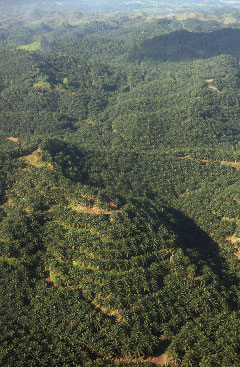Brazil to establish oil palm plantations on degraded Amazon rainforest lands
Brazil to establish oil palm plantations on degraded Amazon rainforest lands
mongabay.com
August 20, 2008
Brazil to compete with Malaysia in palm oil production but environmentalists worry redrawing of forest reserve law will hurt biodiversity conservation efforts.
|
|
Brazil will allow the establishment of oil palm plantations on degraded lands in the Amazon rainforest under an agreement signed between Brazil’s ministers of agriculture and the environment, reports Folha de S. Paulo.
Environment minister Carlos Minc said the proposed law aims to expand biodiesel production in the Amazon without contributing further to deforestation, but environmentalists argue the plan will effectively cut the amount of forest landowners are required to keep on their property from 80 percent to 50 percent, thereby accelerating forest conversion and breaking an earlier promise by Minc that the government would not change the restriction. The initiative, dubbed “Floresta Zero”, allows a landowner count the planting of oil palm and other exotic species towards their “legal forest reserve” requirement. The existing law mandates the use of native species in forest regeneration for the establishment of legal forest reserves.
Green groups say that because plantations are biologically impoverished relative to natural forests, the plan would hurt biodiversity. 12 NGOs voiced opposition to the proposed changes to the forest code in a statement released Friday.
 Oil palm plantations and heavily logged forest near Lahad Datu, Malaysia. Photo by Rhett A. Butler |
Minc responded to the letter Tuesday. In remarks quoted in Folha de S. Paulo, Minc agreed that the proposal focuses on economic, not ecological, concerns.
“The idea to recover degraded areas with only native species is more interesting to biodiversity, but has no economic stimulus,” he said.
Brazil’s ministry of agriculture estimates that the area of cultivation of palm in the Legal Amazon could expand from 60,000 acres today to more than 6 million hectares without the need to clear forest land.
Palm oil in the Amazon
Environmentalists fear Floresta Zero could provide a new impetus for large-scale plantations in the Amazon. Last month Brazil signed a deal with Malaysia’s Land Development Authority FELDA to establish 100,000 hectares (250,000 acres) of oil palm plantations on forest land near Tefe in the Brazilian state of Amazonas.
Presently little commercial palm oil is produced in the region due partly to the traditional nature of Brazilian farmers and pest concerns, but the entrance of industry-leading Malaysian producers could serve as a model and quickly increase palm oil’s visibility as a viable form of land use. As the world’s highest yielding mass market oilseed, palm oil will likely offer better financial returns than cattle ranching and mechanized soy farms, the dominant agricultural activities in Brazilian Amazon, and will employ larger numbers of people (oil palm plantations may employ roughly one worker per 8-10 ha, whereas a single cowboy can handle 4,000-5,000 head of cattle grazing hundreds of ha of land).
The potential for palm oil plantations in the Brazilian Amazon is vast: the Woods Hole Research Center estimates that 2.283 million square kilometers (881,000 sq miles) of forest land in the region is suitable for oil palm, an area far greater in extent than that which could be converted for soy (390,000 sq km) or sugar cane (1.988 million sq km). Woods Hole calculates this area of forest locks up some 42.5 billion tons (gigatons) of carbon in above-ground biomass, or roughly six times 2006 global emissions. Converting this area for palm would release nearly 60 percent of this carbon.
Oil palm expansion in the Amazon will likely be facilitated by infrastructure projects currently underway in these region, including road-building, port expansion, and new hydroelectric projects. Oil palm producers may also benefit from a “logging subsidy” whereby timber harvested from a tract of land helps offset the cost of establishing a plantation. Before the recent run-up in palm oil prices, logging had been a key element to the profitability of oil palm plantations in Southeast Asia.